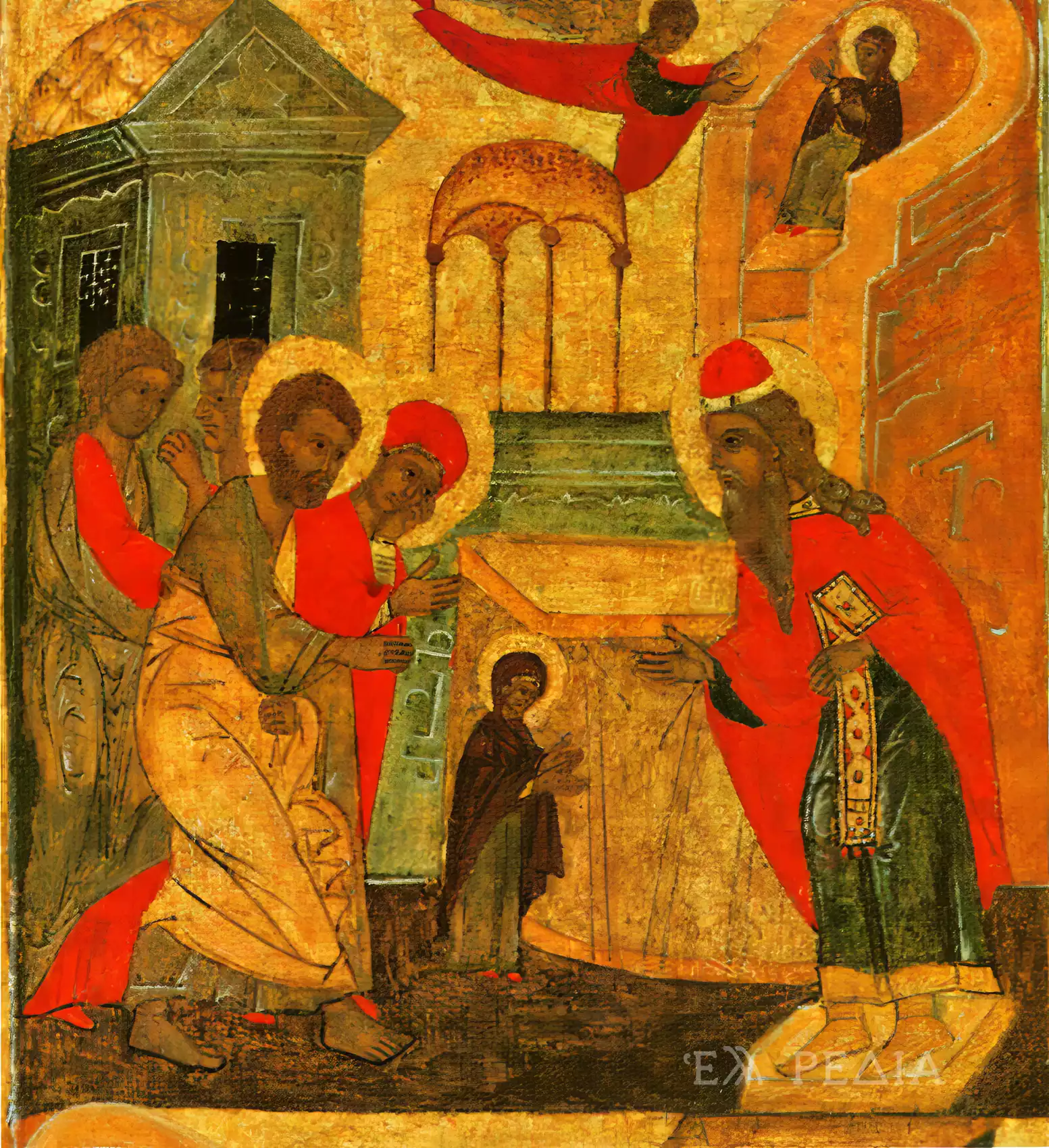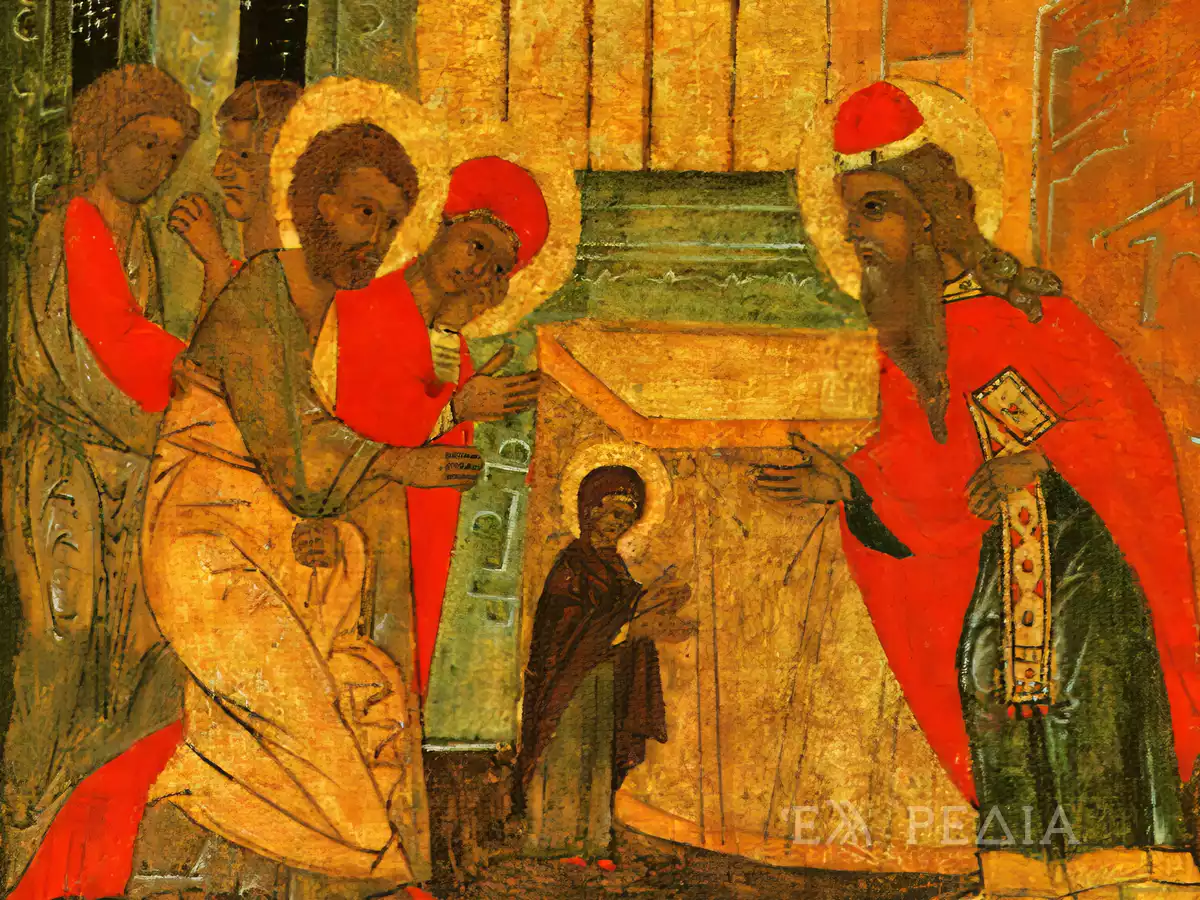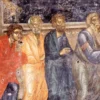 The scene of the Entrance of the Theotokos in Solvytsegondsk is an excellent example of Russian iconographic art of the 16th century
The scene of the Entrance of the Theotokos in Solvytsegondsk is an excellent example of Russian iconographic art of the 16th century
The Entrance of the Theotokos in Solvytsegondsk is one of the most significant works of Russian iconographic art of the 16th century. The icon, dating approximately to 1580-90, captures with exceptional mastery the biblical episode of the three-year-old Virgin Mary’s entrance into the Temple. The scene takes place in an architectural setting that combines Byzantine and Russian elements, with the golden background creating a transcendent atmosphere. The figures are rendered with delicacy and precision, while the intense reds and golds dominate the composition, creating an aesthetic tradition that characterizes Russian iconography of the period. At the center of the composition stands the young Virgin Mary, surrounded by her parents, Joachim and Anna, while the High Priest Zacharias welcomes her at the entrance of the Temple. The icon is an outstanding example of the artistic flourishing that the region of Solvytsegondsk experienced during the 16th century, under the patronage of the powerful Stroganov family.
Iconographic Analysis and Symbolism
The image of the Entrance of the Theotokos in Solvytsegondsk is an excellent example of Russian iconography of the 16th century (Zweig). The composition unfolds on multiple levels, with the architectural depth shaped by buildings that combine Byzantine and Russian elements, creating a complex spatial environment. At the center of the scene, the young Virgin Mary is depicted with exceptional delicacy ascending the steps of the Temple, while the High Priest Zacharias formally welcomes her at the entrance.
The scene is watched with emotion by the Theotokos’s parents, Joachim and Anna, while the virgins of the Temple hold lighted candles, symbols of faith and purity, as they await the entry of the Mother of God. The iconographic tradition of the theme closely follows the model set in Byzantine art, albeit with all the decorative richness of 16th-century Russian iconography and a coloring that is full of meaning.
The dominant golden background of the icon creates a sense of transcendence and eternity. This is especially appropriate for the icon because its subject—the Entrance—has long been considered a prefiguration of the Incarnation of the Divine Word. It is not unusual for an icon to have a simple background; but an icon that exhibits such a well-defined foreground against the kind of shimmering gold that characterizes this piece is probably a rare find. Even so, the icon is not without considerable complexity. The figures are arranged on different levels.
The image’s symbols are many and layered, with each part carrying profound theological significance. The staircase that the young Mary climbs signifies spiritual progress, with the fifteen steps representing the fifteen gradual psalms. The architectural embellishments, with their boxes and columns, denote the heavenly Temple, while the draperies stretched between the buildings serve to create a sense of festivity around this momentous occasion.
The most outstanding aspect of the work is how the faces are rendered. They possess an inner vitality and expressiveness that even the strict typology of the Russian iconographic tradition can’t suppress. The artist has endowed the figures with subtle accents and chiaroscuro. Also, despite their frontal orientation, the bodies have a natural grace that speaks of the creator’s artistic maturity.
Stylistic Characteristics
The examination of the stylistic characteristics of the image of the Entrance of the Theotokos in Solvytsegondsk reveals the high artistic quality of the work. The complex architectural depth creates successive levels that highlight the artist’s skill in rendering space. The building volumes combine elements of Byzantine and Russian architectural tradition, creating an environment that transcends everyday reality.
The color palette of the work is dominated by the gold of the background and the intense reds of the garments. The processing of Russian icons highlights the artist’s unique technique (Tuminskaya). The forms are shaped with exceptional delicacy in the rendering of details, while their posture, despite the strict frontal orientation imposed by the iconographic tradition, maintains a natural grace that reveals the artistic maturity of the creator.
The technique of egg tempera used in the work permitted the artist to make very subtle gradations in the appearance of light on the surfaces. The use of gold leaf in the background and in chosen places on the garments adds an unearthly radiance that helps with the intent of the work overall.
The folds of the garments handled by the artist are particularly impressive, forming intricate geometric patterns that combine traditional techniques from the Byzantine period with elements from the 16th-century Russian artistic tradition. Yet, while the rigorousness of that artistic tradition might suggest a very mechanical way of putting the figures together, the fine chiaroscuro and soft accents of the faces give the figures an inner vitality not always seen in icons. The piece showcases the intricate artistry of color layering, using an incredible number of successive applications of color to create the desired effect. The painting’s colors, applied from dark to light, pop with a dazzling brilliance. This is done in the tradition of Russian icon painting, of which this work is a notable contemporary example. The artist’s handling of the technique is particularly evident in the depiction of the figures’ flesh and clothing.
 The Entrance of the Theotokos in Solvytsegondsk captures the moment of the three-year-old Mary entering the Temple, accompanied by her parents
The Entrance of the Theotokos in Solvytsegondsk captures the moment of the three-year-old Mary entering the Temple, accompanied by her parents
Historical and Religious Context
The image of the Entrance of the Theotokos in Solvytsegondsk was created during a period of great prosperity for iconographic art in Russia. The second half of the 16th century marks a time of intense artistic activity, supported by powerful families such as the prominent patrons of the arts (Parfentieva & Parfentiev).
Solvytsegondsk became a crucial hub of Russian iconography, where nearby workshops skillfully melded the time-honored techniques of the Byzantine tradition with local, Russian elements—hallowing our very distinct icons until, as in the case of the depiction of the Entrance, they were practically indistinguishable from old Russian art. The Entrance icon itself, while styled in Eastern Orthodox sensibilities, is virtually a melting pot of different artistic traditions, and if you look closely enough—or maybe not so closely, because the message is pretty clear—you’ll see that the composition strongly conveys both the theological and spiritual meanings of the event depicted.
Within Russian iconographic tradition, the theme of the Entrance of the Theotokos assumes a significance that stretches far beyond mere artistic representation. In Russian Orthodox culture, the event celebrated on November 21—namely, the entrance of a three-year-old Mary into the Temple—might rightly be considered a centerpiece of both Mariological and visual liturgical culture, as evidenced by the large number of icons that depict the scene.
This icon was made during a time of intense spiritual and artistic exploration in 16th-century Russian society. The period saw sustained efforts to combine the heritage of Byzantine art and local Russian expression, yet it also delved more profoundly into the theology of iconography. The result of this period of intensive exploration was the production of works that had great depth and, some would say, even great complexity.
The present-day home of the icon, the Museum of History and Art of Solvytsegondsk, stands as a vital center for the scholarly pursuit of Russian iconographic art. It possesses terrific examples of local artistic output of the period. The museum’s collection—if you can call it that, for it seems more a part of an accumulated body of work held in trust until such time as the much-seen icon can be returned to its appearance in a place of honor and devotion—offers up almost priceless insights into the making of a half-millennium-old tradition of iconography.
Furthermore, the collection of the museum chronicles the technical innovations and stylization developments that identified this era of Russian sacred art. The workshop traditions of Solvytsegondsk greatly influenced the development of unique local styles while ensuring that the broader Orthodox artistic tradition remained intact.
The School of Solvytsegondsk
The iconography school of Solvytsegondsk shaped a unique artistic tradition that significantly influenced the development of Russian religious art. The creative activity of the area was supported by the expertise and spiritual guidance of experienced iconographers, who masterfully combined the Byzantine tradition with local elements.
The distinctiveness of the Solvytsegondsk school is in the colorful and highly detailed technique of form rendering. Solvytsegondsk artists developed a unique way of approaching faces. They used layers of color to achieve a transparency and depth effect in the flesh that makes any face they render appear both exceptional and real.
Solvytsegondsk’s works use the technique of color layering, which gives brightness and a certain spirituality to the forms. The iconographers who influence his work used a similar method, but they went further. They moved not just from dark to light, but from color to color, using a palette of , or maybe even a virtual color wheel, to create form and, with it, the illusion of depth. They used a medial image of the painting itself as a kind of icon.
The school’s artistic expression hinges on the use of a golden background and intense colors, especially red, to create a transcendent atmosphere. The works’ heightened use of gold leaf in the background and in certain choice areas of the garments gives the art a metaphysical aspect that leaves everyday reality in the dust.
One thing that’s also a distinctive part of the school is the basic structure of the compositions. The iconographers of Solvytsegondsk have developed a special skill in space organization. They combine elements of the Byzantine and Russian architectural traditions into harmonious compositions. These compositions serve the theological and spiritual essence of what is depicted in the icons.
The Entrance of the Theotokos in Solvytsegondsk, a Spiritual Legacy
The image of the Entrance of the Theotokos in Solvytsegondsk is an excellent example of 16th-century Russian iconographic art. The composition, technique, and spiritual dimension reflect the long artistic tradition of the area and its special relationship with Byzantium. The delicate processing of the forms, the use of a golden background and intense colors, as well as the harmonious composition of architectural elements create a work of exceptional artistic and spiritual value. The icon remains to this day one of the most significant examples of Russian iconography, bearing witness to the high art of the workshops of Solvytsegondsk and the rich spiritual tradition of Russian Orthodoxy.
elpedia.gr
Bibliography
Parfentieva, NV, and NP Parfentiev. “The Development of Arts in the Context of the Stroganovs’ Activity as Ktitors and Art Patrons in the 16th-17th Centuries.” ResearchGate (2020).
Tuminskaya, OA. “Russian Foolishness and Images of Fools in the Museum of Icons in Recklinghausen.” Cyberleninka (2020).
Zweig, P. “Icons 11th-18th centuries.” Google Books (2024).

